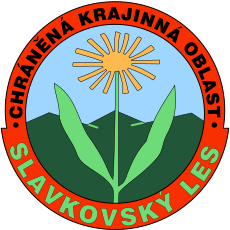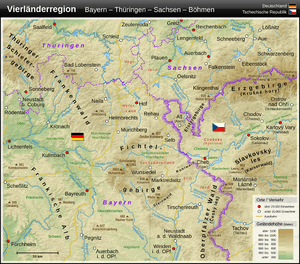Slavkovský les
Slavkovský les,[1] (Slavkov Forest), also called the Emperor's Forest,[1] (German: Kaiserwald), is a mountain range in the Czech Republic in the triangle formed by the towns of Karlovy Vary, Mariánské Lázně and Františkovy Lázně.
| Slavkovský les | |
|---|---|
.jpg) Typical landscape in Slavkovský les
 | |
| Highest point | |
| Peak | Lesný |
| Elevation | 983 m (3,225 ft) |
| Geography | |
 The Slavkovský les in the west of the Czech Republic
| |
| State | Czech Republic |
| Range coordinates | 50°03′00″N 12°40′00″E |
Slavkovský Les is a huge water source with direct importance for a large surrounding area, with many notable springs (including mineral water flows). Some of the water from Slavkovský Les is used in spas in the western parts of the country.
Protections
A large part of Slavkov Forest, 606 km² all in all, is protected area, known as Slavkovský Les Protected Land Area, or Slavkovský Les PLA for short. The name Slavkovský Les (and Slavkov Forest) is used for both the entire mountain range and this protection indiscriminately. The Slavkovský Les protection was established in 1974, with headquarters in Karlovy Vary, and the protection includes 10 small individual reserves, 12 nature monuments, and 3 national nature monuments.[2]
Flora
The ancient and heavily eroded mountain range, is home to a diverse range of habitats, plants and animals. The southwestern parts holds extensive raised bogs, a peculiar habitat with rare plants like bilberry willow trees (Salix myrtilloides) and the carnivorous round-leaved sundew (Drosera rotundifolia) and common butterwort (Pinguicula vulgaris). Woodlands cover more than half of the protection, and they are dominated by spruce, with only small remnants of the original beech forest left. The various rock types of the eroded mountains each hosts unique ecosystems. Where serpentinite rock dominates for example, relicts of old-growth scots pine woods can be found in a mix with interesting plants like spleenwort ferns, including serpentine spleenwort (Asplenium cuneifolium), and flowering herbs such as winter heath (Erica carnea), box-leaved milkwort (Polygala chamaebuxus), and the rare sandwort-leaved mouse-ear (Cerastium alsinifolium) that only grows in these forests. In glades and open areas of Slavkov Forest, several types of orchids and herbs are also found, including the fragrant, and bright yellow, symbol of the Slavkovský Les protection: mountain arnica (Arnica montana).[2][3][4][5]
- Deciduous woods (Žižkův vrch nature reserve)
.jpg) Conifer dominates most parts of the forests
Conifer dominates most parts of the forests.jpg) Scots pine remain in some areas
Scots pine remain in some areas.jpg) Spleenwort ferns
Spleenwort ferns.jpg) Mountain arnica
Mountain arnica_(3).jpg) Sandwort-leaved mouse-ear
Sandwort-leaved mouse-ear
Fauna
The fauna is also diverse, but mostly with well-known animals such as deer, wild boar and several types of martens, but also wood grouse and ground squirrel, the westernmost location of this particular species. Birds are abundant, including birds of prey and owls in unusual large numbers. Woodpeckers, such as the great spotted woodpecker, might be heard from mid-winter till summer, and the migratory black storks, are regular breeders in Slavkov Forest.[2][3]
Threats
The Slavkov Forest has suffered several human disturbances with lasting effects in the last 150 years or so. Because of the soil composition and local geology, tree growth is innately slow in most parts of the Slavkov Forest, and this makes it more difficult than usual for the forests here to recover from any damage or disturbance.
In 1874 to 1894, mono-plantations with European spruce where introduced to some parts, and even-aged spruce woods are still here today. The spruce are not doing well in areas with serpentinite rocks, which leaves safespaces for the original scots pine. In the 1970s and 1980s, the northwestern parts of Czech Republic was badly affected by atmospheric deposition of sulfur. The sulfur is naturally transformed to sulfuric acid, commonly known as acid rain, and this is toxic to plants, and to a lesser degree animals. Visitors to the area, also inevitably bring in plants and seeds foreign to the original habitat, and some of these new ruderal plants can outcompete local species. In modern times, the tree growth is also stressed from deer and muflon foraging on young trees.[5][3]
Gallery
- Landscapes and nature
.jpg) Extensive grasslands and meadows
Extensive grasslands and meadows Pastures and forested low hills
Pastures and forested low hills View of Lesný, the highest hill in Slavkov Forest
View of Lesný, the highest hill in Slavkov Forest.jpg)
.jpg) Teplá River, the biggest of many smaller streams
Teplá River, the biggest of many smaller streams.jpg) Heavily eroded outcrops
Heavily eroded outcrops.jpg) Small streams and springs
Small streams and springs.jpg) Small lakes and extensive boglands
Small lakes and extensive boglands
- Features
- National natural monuments (Křížky)
 Cultural monuments (ruins of Andělská Hora castle)
Cultural monuments (ruins of Andělská Hora castle).jpg) Strange geological formations (Mariánské Lázně Geopark)
Strange geological formations (Mariánské Lázně Geopark) Hiking huts (Beethoven's gazebo - "Beethovenův altán")
Hiking huts (Beethoven's gazebo - "Beethovenův altán") Small villages
Small villages.jpg) One of several observation towers (Goethe's view - "Goethova vyhlídka")
One of several observation towers (Goethe's view - "Goethova vyhlídka").jpg) Spa town Mariánské Lázně in the southern parts
Spa town Mariánské Lázně in the southern parts View across Karlovy Vary in the northern parts
View across Karlovy Vary in the northern parts
Literature
- Jiří Majer: Těžba cinu ve Slavkovském lese v 16. stoleti, Prague, 1970
- Jiří Majer: Die Forstwirtschaft und Holzverwendung in den böhmischen Bergrevieren des Westerzgebirges und des Kaiserwaldes während des 16. Jahrhunderts. in: Sächsische Heimatblätter 43(1997)1, pp. 11–18
References
- Karlovy Vary/Czech Republic at www.sachsen.de. Retrieved 14 Nov 2016.
- "PLA Administration Slavkovský les". AOPK ČR. Retrieved 11 September 2019.
- "Slavkov Forest". Tourist portal of Karlovy Vary Region. Retrieved 11 September 2019.
- "Plants of Slavkov Forest". Czech Mountains. eProgress. Retrieved 11 September 2019.
- Krám, Pavel; Oulehle, Filip; Štědrá, Veronika; Hruška, Jakub; Shanley, James B.; Minocha, Rakesh; Traister, Elena (June 2009). "Geoecology of a Forest Watershed Underlain by Serpentine in Central Europe". Northeastern Naturalist. 16 (sp5): 309–328. doi:10.1656/045.016.0523.
External links
| Wikimedia Commons has media related to: |